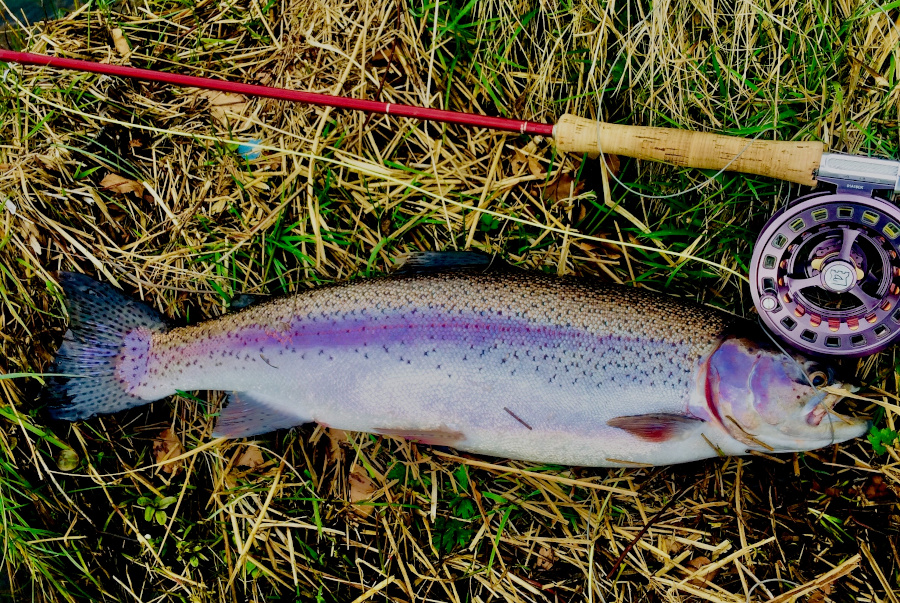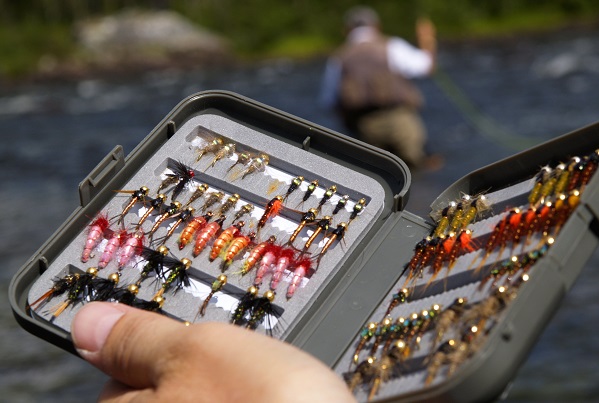When it comes to trout fly fishing, choosing the right rod is crucial for your success and enjoyment on the water. With so many options available, it can be overwhelming to find the perfect trout fly rod that suits your needs. In this comprehensive buyer’s guide, we’ll dive into the key factors to consider when selecting a single handed fly rod for trout fishing, including length, action, line weight, handle types, rod fittings, and additional points that can make a difference in your fishing experience.
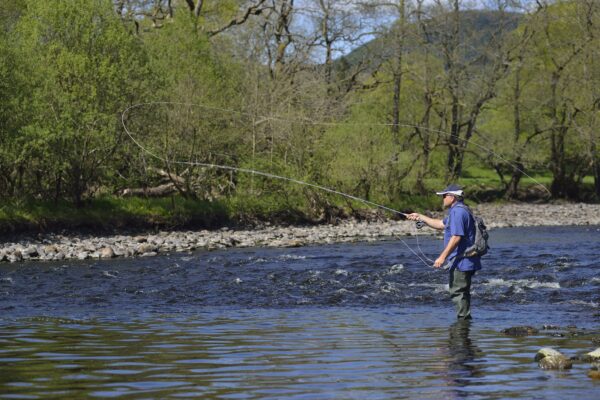
Fly Rod Length: Finding the Perfect Balance
The length of your fly rod should be dictated by the style of fishing and type of water you intend to fish. For small streams and rivers where distance casting isn’t normally required and casting conditions can be tight due to bankside vegetation, consider shorter rods ranging from 7 to 8.5 feet. 9 foot rods are commonly used on larger rivers where longer casts are sometimes necessary and the longer length provides more reach allowing you to mend the line accurately. These provide precise control and accuracy and allow you to manoeuvre easily around obstacles. On the other hand, longer rods between 9 and 10 feet are ideal for situations that require longer casts, better line mending, and increased line control. For the majority of stillwater trout fishing in the UK, a 9 to 10 foot rod is ideal, with the slightly longer 10 foot rod often being favoured for boat fishing. Longer rods of 11 foot and more are often used for specialised applications such as nymphing in flowing water, where the longer rod provides extra reach.
Fly Rod Action: Unleashing the Power
Understanding a fly rod’s action is essential for selecting a fly rod that matches your casting style and fishing needs. Fast action rods offer stiffness and quick recovery, this allows for powerful and accurate long-distance casts, making them suitable for windy conditions and casting larger flies or heavy sinking lines. Fast action rods are commonly used by stillwater trout anglers, both from the bank and boat, who fish teams of flies on a variety of different line densities and where casting distance can sometimes be crucial to catching. Medium action rods strike a balance between power and flexibility, making them versatile for different casting distances and fly sizes. Medium action rods are often used on stillwaters and rivers when casting distance isn’t so much of a concern and a more delicate presentation is required, such as when fishing dry flies or smaller nymphs. For delicate presentations often required when fishing with small dry flies and lighter tippets, a slow or through action rod, with their gentle bending curve are the go-to choice providing a delicate presentation of your fly and to help cushion the shock of a take, helping protect light tippets.
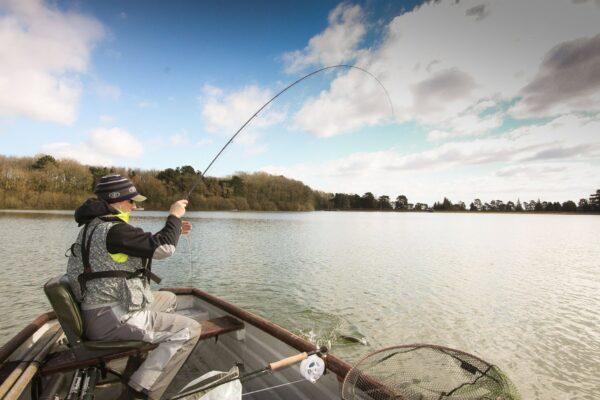
A fast action rod bends in the tip but has plenty of power lower down

A mid/slow action bends throughout the length of the rod and helps protect lighter tippets
Line Weight: The Backbone of Your Rod
The line weight you choose for your fly rod is largely dictated by the style of fishing you intend to do and, to a degree, the types of waters you plan on fishing.
Lighter line weights (#3-#4) are perfect for fishing rivers and streams where a delicate presentation is crucial. They allow for precise casts, accurate presentations, and are suitable for smaller flies. If you enjoy fishing in smaller waters and focusing on finesse, a light line weight rod will be your go-to choice. Due to their lighter mass, light line weights can often be affected by the wind so aren’t always the best choice when fishing open, exposed venues
Line weight of #5-#6 strike a balance between finesse and versatility. They are commonly used on rivers or when fishing stillwaters with smaller flies and lighter tippets. With a #5 or #6 line, you can achieve a good balance of casting distance, accuracy, and presentation. These lines are often the go-to choice for anglers fishing dry flies on both rivers and stillwaters.
When it comes to stillwater trout fishing #7 fly rods are often by far the most popular choice for many anglers, for both boat and bank fishing. They provide excellent casting distance, making them ideal for covering larger bodies of water, while the line weight will also handle larger flies or teams of multiple flies with ease. When fishing stillwaters, either from the boat or bank, a range of line densities from floating to fast sinking are often used, a #7 fly rod will accommodate a range of line densities with ease. The heavier mass of a #7 fly line also helps combat windier conditions allowing good casting distance to be achieved, even in a stiff breeze. Stillwater trout anglers will occasionally move up to a #8 rod when extra power is required.
Selecting the appropriate line weight depends on the fishing style you intend to do and personal preference. Consider the size of the water you fish, the average size of the flies you’ll be using, and the type of presentation you want to achieve. By choosing the right line weight, you can optimise your casting performance and enhance your chances of success on the water.
Fly Rod Handle Types: Comfort and Grip
The majority of fly rod handles are made from cork, although some rods do offer an EVA grip or a mix of cork and EVA, and are usually a full-wells or half-wells shape. Cork handles offer a comfortable grip in a range of situations – they don’t feel cold to the touch when the temperature drops and don’t get slippery when wet. The shape of the rod handle is often dictated by the rod length and line weight. Smaller, lighter rods often have a half-wells grip which allows a comfortable grip and aids accurate, delicate casting styles. Higher line weight rods commonly have a full-wells handle style, the flared end of a full-wells provides the angler a firm grip and allows you to put your thumb behind the rod, perfect for adding some extra stability when making long, powerful casts.
Higher line weight, more powerful rods often feature a fighting butt too – the fighting butt protrudes from the end of the rod below the reel seat and allows the angler to tuck the rod into their side/under their arm and apply additional power when fighting large, strong fish.

Using the rod’s fighting butt to apply pressure to a hard fighting trout
Fly Rod Fittings: Built to Last
The quality of rod fittings can significantly impact the overall performance and durability of your trout fly rod. Pay attention to two key fittings: the reel seat and guides. A reel seat should securely hold your reel in place without any wobbling, ensuring a stable connection between the rod and reel. Look for materials like aluminium or graphite, which offer both strength and lightweight design. When it comes to guides, they should be securely attached, aligned correctly, and feature a smooth surface to prevent any friction that could damage your fly line. There are 3 main styles of guides found on fly rods: Single-leg guides, snake guides and stripper guides.
Single-leg guides are lightweight and commonly found on modern fly rods. These guides consist of a single metal leg that attaches to the rod. Single-leg guides are known for their minimalistic design, which reduces weight and increases sensitivity. They allow for smoother line flow and better line control during casts and retrieves. Single-leg guides are often used on lighter weight rods, such as those designed for small stream fishing or delicate presentations.
Snake guides, also referred to as snake-style guides, are durable and well-suited for heavier line weights rods. The snake guide’s design helps distribute stress evenly along the rod, allowing for smoother and more accurate casts. Additionally, these guides are excellent at reducing line friction and facilitating longer casts with minimal resistance.
Stripper guides, also known as the first guide, are the largest guides found at the base of the rod. They play a crucial role in quickly stripping line off the reel during casting and retrieving. Stripper guides are typically larger in diameter compared to the other guides on the rod, allowing for the smooth passage of the fly line and preventing any tangling or line snags. These guides are especially important when using heavy line weights, shooting heads.
It’s worth noting that the quality and craftsmanship of the guides are essential. Ensure that the guides are securely attached to the rod, aligned correctly, and have smooth surfaces without any rough edges that could damage the fly line. Well-constructed guides will enhance the overall performance of your trout fly rod and provide a seamless fishing experience.
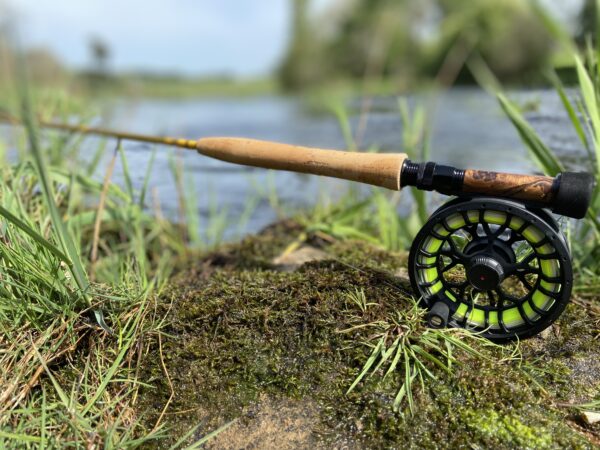
A half-wells cork handle and wooden/metal reel seat
So What Rod Should You Choose?
In summary no one fly rod is going to be suitable for every trout fishing situation and there are several factors to consider when purchasing a fly rod. Rod length and line weight should be the first thing to consider – this is going to be dictated by your preferred fishing style and the fishing situations you’re most likely to face out on the water. After you’ve decided on the rod length and line weight that’s best going to suit your needs, things like rod action, fitting and handle style can be considered.
The points above should help you to make an informed decision on what rod is best going to suit your needs but below we’ll list some of the most popular length/line weight combinations as well as the fishing styles they’re best suited for:
| 8’ #4 | Small streams/rivers – small, light flies and targeting smaller fish |
| 9’ #5 | Rivers/small stillwaters – dry flies and small light flies, usually with a floating line |
| 9’ #6 | Larger Stillwaters – with smaller flies/dry flies and floating/intermediate lines |
| 10’ #7 | Stillwaters – Fishing a range of flies/teams of flies with multiple line densities from floating to fast sinking |
Browse our extensive range of trout fly rods now!



